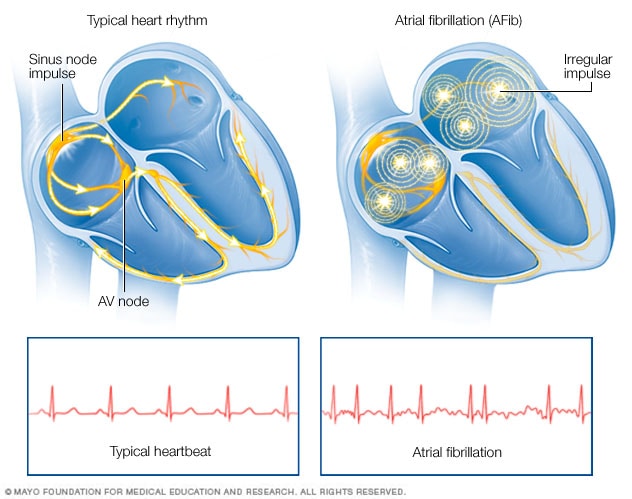Physical Address
304 North Cardinal St.
Dorchester Center, MA 02124
Physical Address
304 North Cardinal St.
Dorchester Center, MA 02124

Contents
Atrial fibrillation, commonly known as AFib, is a prevalent heart condition characterized by irregular and often rapid heartbeats originating in the upper chambers of the heart. This condition affects millions of adults in the United States and can lead to various cardiovascular complications, including an increased risk of stroke, heart failure, and other heart-related issues. AFib occurs when the heart’s upper chambers, known as the atria, beat chaotically and out of sync with the lower chambers, called the ventricles.
Symptoms of AFib may vary from person to person, with some individuals experiencing a fast, fluttering, or pounding heartbeat (palpitations), chest pain, dizziness, fatigue, lightheadedness, reduced exercise tolerance, shortness of breath, and weakness. It’s important to note that some people with AFib may not exhibit any noticeable symptoms, making it crucial to undergo regular screenings and check-ups to detect the condition.
AFib is typically diagnosed through an electrocardiogram (ECG or EKG) that records the heart’s electrical activity. Treatment options for AFib include medications to control heart rhythm, cardioversion to restore a regular heartbeat, and procedures such as catheter ablation to correct faulty heart signals. Patients with AFib are also often prescribed blood thinners to reduce the risk of stroke, a common complication associated with this condition.
When it comes to AFib, understanding what constitutes a dangerous heart rate is essential for managing the condition effectively and preventing potential complications. In AFib, the heart rate can vary significantly, ranging from excessively fast (referred to as rapid ventricular response) to dangerously slow (bradycardia). Both extremes in heart rate can lead to symptoms such as chest pain, shortness of breath, dizziness, and fainting, indicating the need for medical attention.
Medical guidelines offer varying thresholds for heart rates that may be considered dangerous or indicative of potential instability in AFib patients. The Advanced Cardiovascular Life Support guidelines suggest intervention for heart rates exceeding 150 beats per minute, while other recommendations propose evaluation for rates over 120 beats per minute. Symptoms such as chest pain, shortness of breath, dizziness, fainting, or confusion alongside a rapid heart rate warrant prompt medical assessment.
The safety of a person’s heart rate in AFib depends on factors like overall health, age, existing medical conditions, and the presence of symptoms. Resting heart rates above 100–120 beats per minute are generally considered concerning, especially if accompanied by symptoms. However, individualized care and monitoring are crucial to determine a target heart rate that balances symptom management with safety for each patient.
While AFib itself may not be life-threatening, it requires proper treatment and management to prevent complications like stroke and heart failure. Lifestyle modifications, including controlling blood pressure, cholesterol, and diabetes, avoiding tobacco and excessive alcohol consumption, maintaining a healthy weight, and managing stress, can help reduce the risk of AFib and promote heart health.
If you experience symptoms of AFib, such as palpitations, chest pain, dizziness, or fatigue, it’s crucial to consult a healthcare provider for evaluation and appropriate management. Early detection and intervention can significantly impact the prognosis of AFib and reduce the risk of associated complications like stroke.
Understanding the significance of heart rate management in AFib is paramount for individuals living with this condition. By recognizing dangerous heart rate thresholds, monitoring symptoms, and seeking timely medical assistance, patients can effectively manage AFib and reduce the risk of adverse outcomes. With proper diagnosis, treatment, and lifestyle adjustments, individuals with AFib can lead fulfilling lives while safeguarding their heart health.